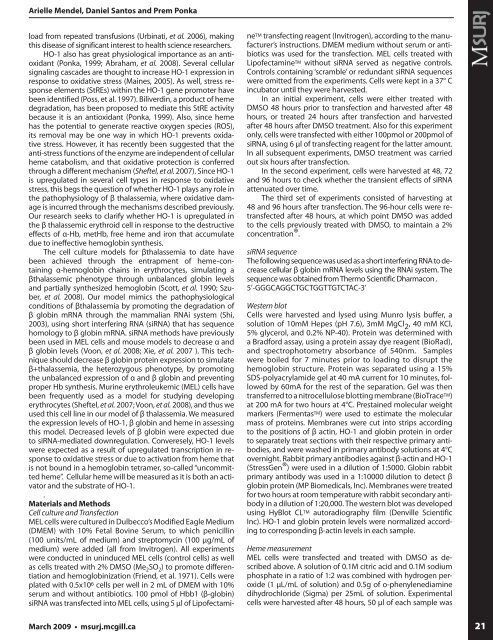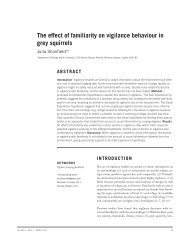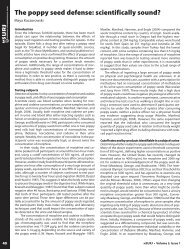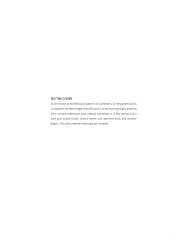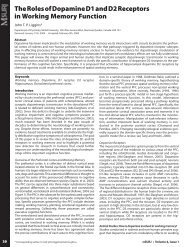the entire issue - McGill Science Undergraduate Research Journal ...
the entire issue - McGill Science Undergraduate Research Journal ...
the entire issue - McGill Science Undergraduate Research Journal ...
Create successful ePaper yourself
Turn your PDF publications into a flip-book with our unique Google optimized e-Paper software.
Arielle Mendel, Daniel Santos and Prem Ponka<br />
load from repeated transfusions (Urbinati, et al. 2006), making<br />
this disease of significant interest to health science researchers.<br />
HO-1 also has great physiological importance as an antioxidant<br />
(Ponka, 1999; Abraham, et al. 2008). Several cellular<br />
signaling cascades are thought to increase HO-1 expression in<br />
response to oxidative stress (Maines, 2005). As well, stress response<br />
elements (StREs) within <strong>the</strong> HO-1 gene promoter have<br />
been identified (Poss, et al. 1997). Biliverdin, a product of heme<br />
degradation, has been proposed to mediate this StRE activity<br />
because it is an antioxidant (Ponka, 1999). Also, since heme<br />
has <strong>the</strong> potential to generate reactive oxygen species (ROS),<br />
its removal may be one way in which HO-1 prevents oxidative<br />
stress. However, it has recently been suggested that <strong>the</strong><br />
anti-stress functions of <strong>the</strong> enzyme are independent of cellular<br />
heme catabolism, and that oxidative protection is conferred<br />
through a different mechanism (Sheftel, et al. 2007). Since HO-1<br />
is upregulated in several cell types in response to oxidative<br />
stress, this begs <strong>the</strong> question of whe<strong>the</strong>r HO-1 plays any role in<br />
<strong>the</strong> pathophysiology of β thalassemia, where oxidative damage<br />
is incurred through <strong>the</strong> mechanisms described previously.<br />
Our research seeks to clarify whe<strong>the</strong>r HO-1 is upregulated in<br />
<strong>the</strong> β thalassemic erythroid cell in response to <strong>the</strong> destructive<br />
effects of α-Hb, metHb, free heme and iron that accumulate<br />
due to ineffective hemoglobin syn<strong>the</strong>sis.<br />
The cell culture models for βthalassemia to date have<br />
been achieved through <strong>the</strong> entrapment of heme-containing<br />
α-hemoglobin chains in erythrocytes, simulating a<br />
βthalassemic phenotype through unbalanced globin levels<br />
and partially syn<strong>the</strong>sized hemoglobin (Scott, et al. 1990; Szuber,<br />
et al. 2008). Our model mimics <strong>the</strong> pathophysiological<br />
conditions of βthalassemia by promoting <strong>the</strong> degradation of<br />
β globin mRNA through <strong>the</strong> mammalian RNAi system (Shi,<br />
2003), using short interfering RNA (siRNA) that has sequence<br />
homology to β globin mRNA. siRNA methods have previously<br />
been used in MEL cells and mouse models to decrease α and<br />
β globin levels (Voon, et al. 2008; Xie, et al. 2007 ). This technique<br />
should decrease β globin protein expression to simulate<br />
β+thalassemia, <strong>the</strong> heterozygous phenotype, by promoting<br />
<strong>the</strong> unbalanced expression of α and β globin and preventing<br />
proper Hb syn<strong>the</strong>sis. Murine erythroleukemic (MEL) cells have<br />
been frequently used as a model for studying developing<br />
erythrocytes (Sheftel, et al. 2007; Voon, et al. 2008), and thus we<br />
used this cell line in our model of β thalassemia. We measured<br />
<strong>the</strong> expression levels of HO-1, β globin and heme in assessing<br />
this model. Decreased levels of β globin were expected due<br />
to siRNA-mediated downregulation. Converesely, HO-1 levels<br />
were expected as a result of upregulated transcription in response<br />
to oxidative stress or due to activation from heme that<br />
is not bound in a hemoglobin tetramer, so-called “uncommitted<br />
heme”. Cellular heme will be measured as it is both an activator<br />
and <strong>the</strong> substrate of HO-1.<br />
.<br />
Materials and Methods<br />
Cell culture and Transfection<br />
MEL cells were cultured in Dulbecco’s Modified Eagle Medium<br />
(DMEM) with 10% Fetal Bovine Serum, to which penicillin<br />
(100 units/mL of medium) and streptomycin (100 μg/mL of<br />
medium) were added (all from Invitrogen). All experiments<br />
were conducted in uninduced MEL cells (control cells) as well<br />
as cells treated with 2% DMSO (Me 2 SO 2 ) to promote differentiation<br />
and hemoglobinization (Friend, et al. 1971). Cells were<br />
plated with 0.5x10 6 cells per well in 2 mL of DMEM with 10%<br />
serum and without antibiotics. 100 pmol of Hbb1 (β-globin)<br />
siRNA was transfected into MEL cells, using 5 μl of Lipofectami-<br />
ne TM transfecting reagent (Invitrogen), according to <strong>the</strong> manufacturer’s<br />
instructions. DMEM medium without serum or antibiotics<br />
was used for <strong>the</strong> transfection. MEL cells treated with<br />
Lipofectamine TM without siRNA served as negative controls.<br />
Controls containing ‘scramble’ or redundant siRNA sequences<br />
were omitted from <strong>the</strong> experiments. Cells were kept in a 37° C<br />
incubator until <strong>the</strong>y were harvested.<br />
In an initial experiment, cells were ei<strong>the</strong>r treated with<br />
DMSO 48 hours prior to transfection and harvested after 48<br />
hours, or treated 24 hours after transfection and harvested<br />
after 48 hours after DMSO treatment. Also for this experiment<br />
only, cells were transfected with ei<strong>the</strong>r 100pmol or 200pmol of<br />
siRNA, using 6 μl of transfecting reagent for <strong>the</strong> latter amount.<br />
In all subsequent experiments, DMSO treatment was carried<br />
out six hours after transfection.<br />
In <strong>the</strong> second experiment, cells were harvested at 48, 72<br />
and 96 hours to check whe<strong>the</strong>r <strong>the</strong> transient effects of siRNA<br />
attenuated over time.<br />
The third set of experiments consisted of harvesting at<br />
48 and 96 hours after transfection. The 96-hour cells were retransfected<br />
after 48 hours, at which point DMSO was added<br />
to <strong>the</strong> cells previously treated with DMSO, to maintain a 2%<br />
concentration®.<br />
siRNA sequence<br />
The following sequence was used as a short interfering RNA to decrease<br />
cellular β globin mRNA levels using <strong>the</strong> RNAi system. The<br />
sequence was obtained from Thermo Scientific Dharmacon .<br />
5’-GGGCAGGCTGCTGGTTGTCTAC-3’<br />
Western blot<br />
Cells were harvested and lysed using Munro lysis buffer, a<br />
solution of 10mM Hepes (pH 7.6), 3mM MgCl 2 , 40 mM KCl,<br />
5% glycerol, and 0.2% NP-40). Protein was determined with<br />
a Bradford assay, using a protein assay dye reagent (BioRad),<br />
and spectrophotometry absorbance of 540nm. Samples<br />
were boiled for 7 minutes prior to loading to disrupt <strong>the</strong><br />
hemoglobin structure. Protein was separated using a 15%<br />
SDS-polyacrylamide gel at 40 mA current for 10 minutes, followed<br />
by 60mA for <strong>the</strong> rest of <strong>the</strong> separation. Gel was <strong>the</strong>n<br />
transferred to a nitrocellulose blotting membrane (BioTrace TM )<br />
at 200 mA for two hours at 4°C. Prestained molecular weight<br />
markers (Fermentas TM ) were used to estimate <strong>the</strong> molecular<br />
mass of proteins. Membranes were cut into strips according<br />
to <strong>the</strong> positions of β actin, HO-1 and globin protein in order<br />
to separately treat sections with <strong>the</strong>ir respective primary antibodies,<br />
and were washed in primary antibody solutions at 4°C<br />
overnight. Rabbit primary antibodies against β-actin and HO-1<br />
(StressGen®) were used in a dilution of 1:5000. Globin rabbit<br />
primary antibody was used in a 1:10000 dilution to detect β<br />
globin protein (MP Biomedicals, Inc). Membranes were treated<br />
for two hours at room temperature with rabbit secondary antibody<br />
in a dilution of 1:20,000. The western blot was developed<br />
using HyBlot CL TM autoradiography film (Denville Scientific<br />
Inc). HO-1 and globin protein levels were normalized according<br />
to corresponding β-actin levels in each sample.<br />
Heme measurement<br />
MEL cells were transfected and treated with DMSO as described<br />
above. A solution of 0.1M citric acid and 0.1M sodium<br />
phosphate in a ratio of 1:2 was combined with hydrogen peroxide<br />
(1 μL/mL of solution) and 0.5g of o-phenylenediamine<br />
dihydrochloride (Sigma) per 25mL of solution. Experimental<br />
cells were harvested after 48 hours, 50 μl of each sample was<br />
March 2009 • msurj.mcgill.ca<br />
21


